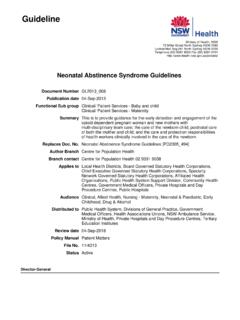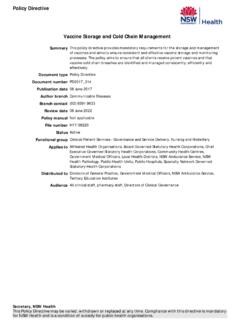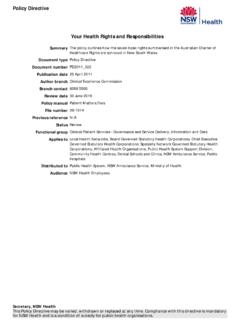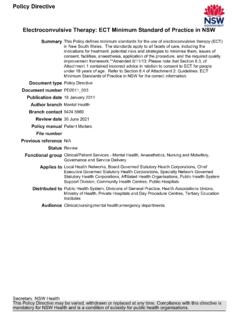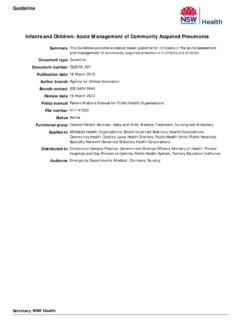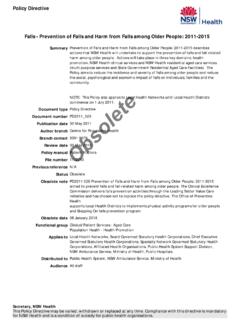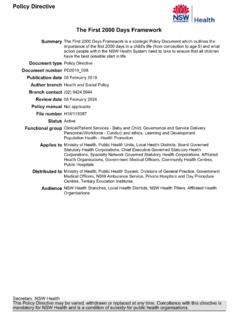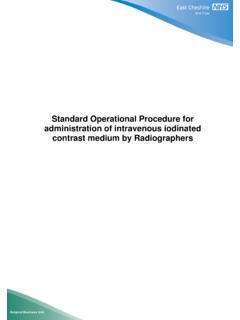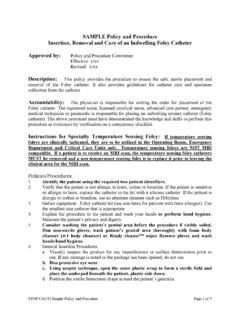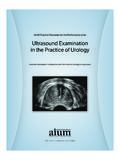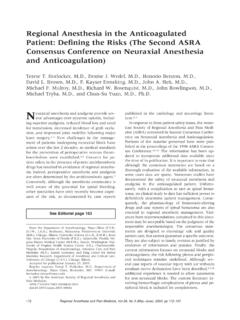Transcription of Adult Urethral Catheterisation for Acute Care …
1 Adult Urethral Catheterisation for Acute care SettingsSummaryThis Guideline describes the best practice principles that should be employed when inserting and managing Urethral catheters in Adult Acute care settings in NSW Public Health Organisations (PHOs).Document typeGuidelineDocument numberGL2015_016 Publication date15 December 2015 Author branchClinical Excellence CommissionBranch contact02 9269 5500 Review date30 September 2021 Policy manualPatient MattersFile numberCEC D15/7851 Previous referenceN/AStatusReviewFunctional groupClinical/Patient Services - Critical care , Infectious Diseases, Surgical, MaternityApplies toLocal Health Districts, Board Governed Statutory Health Corporations, Chief Executive Governed Statutory Health Corporations, Specialty Network Governed Statutory Health Corporations.
2 Affiliated Health Organisations, Public Health System Support Division, Ministry of Health, Public Hospitals, NSW Health Pathology, Cancer InstituteDistributed toPublic Health System, NSW Ambulance Service, Ministry of Health, Private Hospitals and Day Procedure Centres, Tertiary Education InstitutesAudienceHospital administration;nursing;medical;surgical; clinical governance;clinical staffGuidelineSecretary, NSW HealthGUIDELINE SUMMARY Adult Urethral Catheterisation FOR Acute care SETTINGS PURPOSE The purpose of this guideline is to describe the best practice principles that should be employed when inserting and managing Urethral catheters in Adult Acute care settings in NSW Public Health Organisations (PHOs).
3 KEY PRINCIPLES Indwelling urinary catheters are a potential reservoir of infection. To minimise the risk of a patient acquiring a catheter associated urinary tract infection (CAUTI), clinicians should ensure that indwelling Urethral catheters are: Inserted only if clinically indicated Inserted and maintained using aseptic technique Removed as soon as the clinical need has been insertion, routine care and catheter removal should be documented in the patient s healthcare record. USE OF THE GUIDELINE The Chief Executives of NSW PHOs are responsible for the implementation of this Guideline within their services / facilities to ensure that local protocols or operating procedures are in place, aligned and consistent with the Guideline.
4 All clinicians working in Adult Acute care settings and who are involved in the care of patients with catheters should be aware of the Guideline and actively participate in its implementation. The Clinical Excellence Commission will take responsibility for producing resources for PHOs to support the implementation of this guideline. REVISION HISTORY Version Approved by Amendment notes December 2015 (GL2015_016) Deputy Secretary, System Purchasing and Performance New guideline ATTACHMENTS Urethral Catheterisation for Acute care settings: guidelineGL2015_016 Issue date: December-2015 Page 1 of 1 Adult Ur ethral C atheterisation for Acute care Settings GUIDELINE Issue date: December-2015 GL2015_016 Adult Urethral Catheterisation for Acute care Settings GUIDELINE CONTENTS 1 BACKGROUND.
5 1 Purpose .. 1 About this document .. 1 Abbreviations and key definitions .. 1 2 DOES THE PATIENT NEED A CATHETER? .. 2 Indications for catheter insertion .. 2 Inappropriate reasons for catheter insertion .. 2 Confirming urinary retention .. 3 3 WHICH CATHETER SHOULD BE USED? .. 3 Intermittent in / out Catheterisation .. 3 Short term indwelling Urethral Catheterisation .. 4 Suprapubic Catheterisation .. 4 Catheter material .. 4 Catheter size .. 4 Clinical procedure safety .. 5 4 HOW TO INSERT A Urethral CATHETER .. 6 Personal protective equipment.
6 6 Equipment for catheter insertion .. 6 Catheter insertion procedure .. 6 Documenting catheter insertion .. 9 5 HOW TO care FOR THE 10 Shift 10 Drainage .. 10 Daily tasks .. 10 Insertion site and periurethral care .. 10 Other tasks .. 11 Changing drainage devices .. 11 Changing catheters .. 12 Documenting routine catheter care and maintenance .. 12 6 WHEN AND HOW TO REMOVE A CATHETER .. 12 Criteria-l ed catheter removal .. 13 Key principles for trial of void .. 13 Documenting catheter removal .. 14 7 SPECIMEN COLLECTION.
7 14 Rationale for urine specimen collection for 14 Urine specimen collection at catheter insertion .. 15 Urine specimen collection via a sampling port .. 15 Urine specimens for culture .. 15 Documenting urine specimen collection .. 16 PD2015_016 Issue date: December-2015 Contents page Adult Urethral Catheterisation for Acute care Settings GUIDELINE 8 APPROPRIATE ANTIMICROBIAL USE .. 16 Antimicrobial prophylaxis for Catheterisation .. 16 Antimicrobial therapy for catheterisations .. 16 9 ADDITIONAL 16 10 17 PD2015_016 Issue date: December-2015 Contents page Adult Urethral Catheterisation for Acute care Settings GUIDELINE 1 BACKGROUND Purpose The purpose of this guideline is to provide the best practice principles to be applied when inserting and managing Urethral catheters for Adult patients in NSW Public Health Organisations (PHOs), to reduce unnecessary Catheterisation and the risk of the catheter associated urinary tract infection.
8 This document is intended to support all trained and credentialed healthcare clinicians who are competent in urinary catheter practice for Acute care settings. It is the responsibility of the PHO to ensure clinicians whose role involves the insertion, maintenance or removal of Urethral catheters are trained and credentialed. About this document This guideline addresses the insertion, care and removal of Urethral catheters in adults during Acute care . This guideline does not address suprapubic Catheterisation , Acute paediatric Catheterisation or care and use of chronic or long term catheters for Adult patients.
9 This document provides limited advice NSQHS Standard Implementing protocols for invasive device procedures regularly performed within the organisation for maternity and birth settings however these units should refer to local procedures for further clarification. Abbreviations and key definitions ACORN Australian College of Operating Room Nurses Autonomic dysreflexia Autonomic dysreflexia is a sudden and severe rise in blood pressure resulting from overactivity of an isolated sympathetic nervous system below the lesion, triggered by a nociceptive stimulus that can result in intracranial haemorrhage, fits, arrhythmias, hypertensive encephalopathy and even death [1].
10 CAUTI Catheter-associated urinary tract infections Clinical indication Rationale to justify a clinical procedure or treatment Closed system A closed urinary drainage system consists of a catheter inserted into the urinary bladder and connected via tubing to a drainage bag. The catheter is retained in the bladder by an inflated balloon [2]. Credentialing A process used to verify the qualifications and experience of primarily medical practitioners to determine their ability to provide safe, high quality health care services within a specific health care setting [3].
